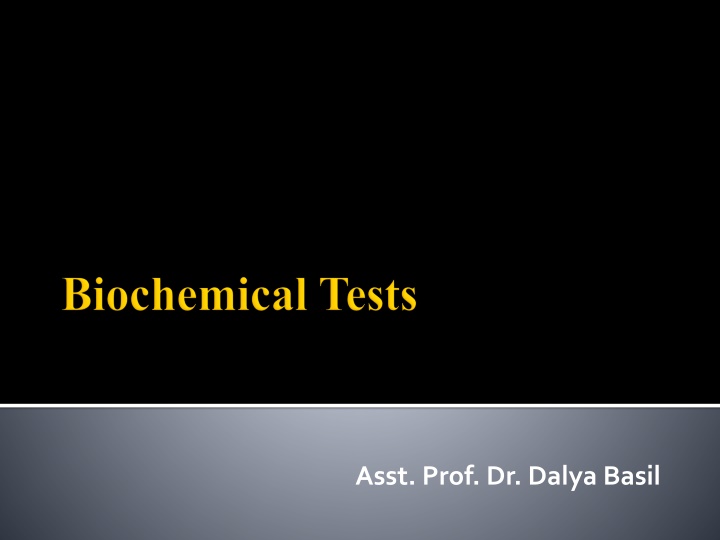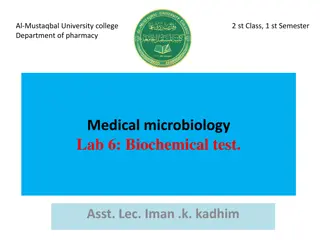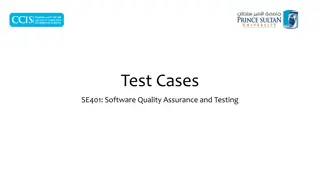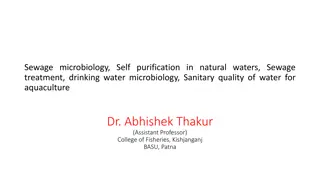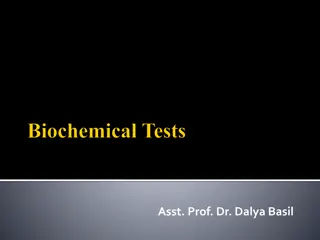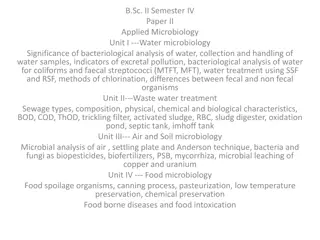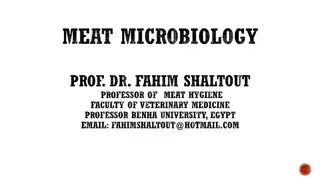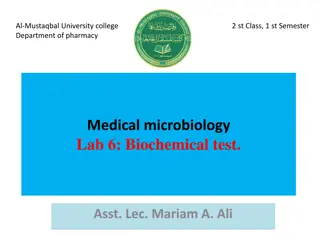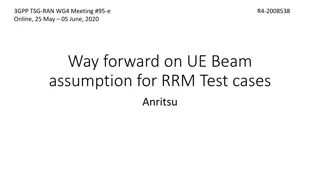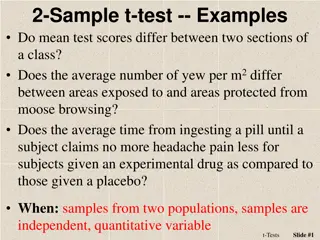Coagulase Test in Microbiology
Coagulase test is a crucial microbiological technique used to differentiate Staphylococcus aureus, which produces coagulase, from other species like S. epidermis and S. saprophyticus that do not. This test helps in identifying the presence of bound and free forms of coagulase, aiding in the accurate diagnosis of infections caused by pathogenic bacteria. The test involves slide and tube methods to detect bound and free coagulase, respectively, providing valuable insights into bacterial species and their pathogenic potential.
Download Presentation

Please find below an Image/Link to download the presentation.
The content on the website is provided AS IS for your information and personal use only. It may not be sold, licensed, or shared on other websites without obtaining consent from the author.If you encounter any issues during the download, it is possible that the publisher has removed the file from their server.
You are allowed to download the files provided on this website for personal or commercial use, subject to the condition that they are used lawfully. All files are the property of their respective owners.
The content on the website is provided AS IS for your information and personal use only. It may not be sold, licensed, or shared on other websites without obtaining consent from the author.
E N D
Presentation Transcript
Coagulase test Catalase test Oxidase test Triple Sugar Iron Test IndoleTest Urease Test Simmons Citrate Test
Coagulase aureus (positive) which produce the enzyme coagulase, from S. epidermis and S. saprophyticus (negative) which do not produce coagulase. test is used to differentiate Staphylococcus Coagulase is an enzyme-like protein and causes plasma to clot by converting fibrinogen to fibrin. Staphylococcus aureus produces two forms of coagulase: bound and free. Bound coagulase (clumping factor) is bound to the bacterial cell wall and reacts directly with fibrinogen. This results in an alternation of fibrinogen so that it precipitates on the staphylococcal cell, causing the cells to clump when a bacterial suspension is mixed with plasma. This doesn t require coagulase-reacting factor.
Free plasma coagulase-reacting factor (CRF), to from a coagulase-CRF complex. This complex in turn reacts with fibrinogen to produce the fibrin clot. coagulase involves the activation of
SlideTest (to detect bound coagulase) Place a drop of physiological saline on each end ofa slide, or on twoseparateslides. With the loop, straight wire or wodden stick, emulsify a portion of the isolated colony in each dropstomake twothick suspensions. Add a drop of human or rabbit plasma to one of thesuspensions, and mixgently. Look for clumping of the organisms within 10 seconds.
TubeTest (to detect free coagulase) The tube test uses rabbit plasma that has been inoculated with a staphylococcal colony (i.e., Gram- positive cocci which are catalase positive). The tube is then incubated at 37 C for 1.5 hours. If negative, then incubation is continued up to 18hours. If 'positive' (e.g., the suspect colony is S. aureus), the plasma will coagulate, resulting in a clot (sometimes the clot is so pronounced, the liquid will completely solidify).
This test demonstrate the presence of catalase, an enzyme that catalyses the release of oxygen from hydrogen peroxide (H2O2). It is used to differentiate those bacteria that produces an enzyme catalase, such as staphylococci, from non-catalase producingbacteriasuchasstreptococci.
The enzyme catalase mediates the breakdown of hydrogen peroxide into oxygen and water. The presence of the enzyme in a bacterial isolate is evident when a small inoculum is introduced into hydrogen peroxide, elaboration of oxygen bubbles occurs. The lack of catalase is evident by a lack of or weak bubble production. The culture should not be more than 24hoursold. 2H2O2 2H2O + O2(gas bubbles) catalase and the rapid
Bacteria thereby protect themselves from the lethal effect of Hydrogen peroxide which is accumulated as an end product of aerobic carbohydrate metabolism. Catalase-positive bacteria include strict aerobes as well as facultative anaerobes. They all have the ability to respire using oxygen as a terminal electron acceptor.
Catalase-negative anaerobes, or they may be facultative anaerobes that only ferment and do not respire using oxygen as a terminal electron acceptor (ie. Streptococci). bacteria may be
The catalase test is primarily used to distinguish among Gram-positive cocci: members of the genus Staphylococcus are catalase-positive, and members of the genera Streptococcus and Enterococcus are catalase-negative. Catalase test is used to differentiate Clostridium, which are catalase negative, from Bacillus species, which are positive.
Catalase test is used for the identification of Mycobacterium tuberculosis. Catalase test can be used as an aid to the identification of Members of Enterobacteriaceae family are catalase positive e.g., (Citrobacter, E. coli, Enterobacter, Klebsiella, Shigella, Yersinia, Proteus, Salmonella, Serratia). Enterobacteriaceae.
Transfer a small amount of bacterial colony to a surface of clean, dry glass slide using a loop or sterile wooden stick Place a drop of 3% H2O2 on to the slide and mix. A positive result is the rapid evolution of oxygen (within 5-10 sec.) as evidenced by bubbling. A negative result is no bubbles or only a few scattered bubbles.
Add 4 to 5 drops of 3% H2O2 (Hydrogen peroxide) to in a test tube Using a wooden applicator stick, collect a small amount of organism from a well-isolated 18- to 24-hour colony and place into the test tube. Place the tube against a dark background and observe for immediate bubble formation (O2 + water = bubbles) at the end of the wooden applicator stick.
The oxidase test detects the presence of a cytochrome oxidase system that will catalyse the transport of electrons between electron donors in the bacteria and a redox dye- tetramethyl-p-phenylene-diamine. The dye is reduced to deep purple color. This test is used to assist in the identification of Pseudomonas, Neisseria, Aeromonas, Campylobacter, Vibrio, Brucella and Pasteurella, all of which produce the enzyme cytochrome oxidase.
A number of reagents can be used for this test. Kovacs Oxidase Reagent: 1% tetra-methyl-p-phenylene-diamine dihydrochloride, in water Gordon and McLeod s Reagent: 1% dimethyl-p-phenylene-diamine dihydrochloride, in water Gaby and Hadley (indophenol oxidase) Reagent: 1% -naphthol in 95% ethanol 1% p-aminodimethylaniline HCL
The Cytochrome containing organisms produce an intracellular oxidase enzyme. This oxidase enzyme catalyzes the oxidation of cytochrome c. Organisms which contain cytochrome c as part of their respiratory chain are oxidase- positive and turn the reagent blue/purple. Organisms lacking cytochrome c as part of their respiratory chain do not oxidize the reagent, leaving it colorless within the limits of the test, and are oxidase-negative.
Oxidase positive bacteria possess cytochrome oxidase or indophenol oxidase. Both of these catalyse the transport of electrons from donor compounds (NADH) to electron acceptors (usually oxygen). The test reagent, N, N, N , N -tetramethyl-p- phenylenediamine dihydrochloride acts as an artificial electron acceptor for the enzyme oxidase. The oxidised reagent forms the coloured compound indophenol blue.
The cytochrome system is usually only present in aerobic organisms which are capable of utilising oxygen as the final hydrogen receptor. The end product of this metabolism is either water or hydrogen peroxide (broken down by catalase).
Triple Sugar Iron Agar (TSI Agar) is used for the differentiation of gram-negative enteric bacilli based on carbohydrate fermentation and the production of hydrogen sulfide.
Carbohydrate fermentation is detected by the presence of gas and a visible color change (from red to yellow) of the pH indicator, phenol red. The production of hydrogen sulfide is indicated by the presence of a precipitate that blackens the medium in the buttom of the tube.
0.1% Glucose: If only glucose is fermented, only enough acid is produced to turn the buttom yellow. The slant will remain red 1.0 % lactose/1.0% sucrose: a large amount of acid turns both buttom and slant yellow, thus indicating the ability of the culture to ferment either lactose or sucrose. Iron: Ferrous sulfate: Indicator of H2S formation Phenol red: Indicator of acidification (It is yellow in acidic condition and red under alkaline conditions). It also contains Peptone which acts as source of nitrogen. (when peptone is utilized under aerobic condition ammonia is produced)
With a sterilized straight inoculation needle touch the top of a well-isolated colony Inoculate TSI Agar by first stabbing through the center of the medium to the bottom of the tube and then streaking on the surface of the agar slant.Incubate the tube at 37 C for 18 to 24 hours.
If lactose (or sucrose) is fermented, a large amount of acid is produced, which turns the phenol red indicator yellow both in buttom and in the slant. Some organisms generate gases, which produces bubbles/cracks on the medium.
If neither lactose/sucrose nor glucose is fermented, both the butt and the slant will be red. The slant can become a deeper red- purple (more alkaline) as a result of production of ammonia from the oxidative deamination of amino acids (peoptone is a major constituents of TSI Agar) . if H2S is produced, the black color of ferrous sulfide is seen.
Name of the organisms Slant Butt Gas H2S Escherichia, Klebsiella, Enterobacter Acid (A) Acid (A) Pos (+) Neg (-) Shigella, Serratia Alkaline (K) Acid (A) Neg (-) Neg (- ) Salmonella, Proteus Alkaline (K) Acid (A) Pos (+) Pos (+) Pseudomonas Alkaline (K) Alkaline (K) Neg (-) Neg (-)
This test demonstrate the ability of certain bacteria to decompose the amino acid tryptophan whichaccumulatesinthe medium. Indole production test is important in the identification of Enterobacteria. Most strains of E. coli, P. vulgaris, and Providencia species break down the amino acid tryptophan with the release of indole. to indole,
This is performed by a chain of a number of different intracellular enzymes, a system generally referred to as tryptophanase. Tryptophan is an amino acid that can undergo deamination and hydrolysis by bacteria that express tryptophanase enzyme.
When indole is combined with Kovacs Reagent (which contains hydrochloric acid and p-dimethylaminobenzaldehyde in amyl alcohol) the solution turns from yellow to cherry red. Because amyl alcohol is not water soluble, the red coloration will form in an oily layer at the top of the broth.
Take a sterilized test tubes containing 4 ml of tryptophan broth. Inoculate the tube aseptically by taking the growth from 18 to 24 hrs culture. Incubate the tube at37 C for 24-28 hours. Add 0.5 ml of Kovac s reagent to the broth culture. Observe for the presence or absence of ring.
Positive: Formation of a pink to red color ( cherry-red ring ) in the reagent layer on top of the medium within seconds of adding the reagent. Examples: Aeromonas hydrophila, Aeromonas punctata, Bacillus alvei, Haemophilus influenzae, Proteus species. (not P. mirabilis and P. penneri), shigelloides, Pasteurella multocida, Pasteurella Enterococcus faecalis, and Vibrio species. Escherichia coli, pneumotropica,
Negative: No color change even after the addition of appropriate Examples: Actinobacillus spp., Aeromonas salmonicida, most Bacillus sp., Bordetella sp., Enterobacter sp., Lactobacillus spp., most Haemophilus sp., most Klebsiella sp., Neisseria sp., Pasteurella haemolytica, Pasteurella ureae, Proteus mirabilis, sp.,Salmonella sp., Serratia sp., Yersinia sp. reagent. Pseudomonas
The urease test is used to determine the ability of an organism to split urea, through the production of the enzyme urease and for the differentiation of enteric bacilli.
Urea is the product of decarboxylation of amino acids. Hydrolysis of urea produces ammonia and CO2. The formation of ammonia alkalinizes the medium, and the pH shift is detected by the color change of phenol red from light orange at pH 6.8 to pink at pH 8.1. Rapid urease-positive organisms turn the entire medium pink within 24 hours. Weakly positive organisms may take several days, and negative organisms produce no color change or yellow as a result of acid production.
This test can be used as part of the identification of several genera and species of Enterobacteriaceae, Proteus, Klebsiella, and some Yersinia and Citrobacter species, Corynebacteriumspecies. It is also useful to identify Cryptococcus spp., Brucella, Helicobacter otherbacteria that produce the urease enzyme. Directly, this test is performed on gastric biopsy samples to detect the presenceof H. pylori. including as well as some pylori, and many
The rapid urease test (RUT) is a popular diagnostic test for diagnosis of Helicobacter pylori. It is a rapid, cheap and simple test that detects the presence of urease in or on the gastric mucosa. It is also known as the CLO test (Campylobacter-like organism test). This test uses a gastric endoscopy and biopsy to collect stomach lining cells.
Simmons' differentiating gram-negative bacteria on the basis of citrate utilization. citrate test is used for Simmons' citrate agar is a defined, selective and differential medium that tests for an organism's ability to use citrate as a sole carbon source and ammonium ions as the sole nitrogen source.
